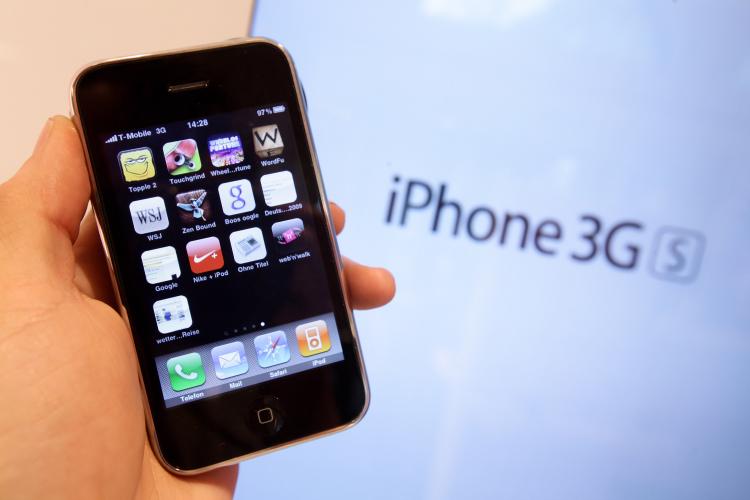Computer and electronics maker Apple Inc.’s strong fiscal second-quarter earnings report surprised few, but its results underscore the company’s resounding success in transforming itself from a computer maker to a personal electronics giant.
Apple’s marquee product, the iPhone smartphone, continues to sell at a high pace. The company sold 8.75 million units of the iPhone worldwide in the latest quarter, an astonishing feat considering that the latest model is almost 9 months old and the company is slated to introduce a new version this summer—in the current quarter.
Analysts expected the company to sell around 7 million units of the iPhone, and it exceeded the forecast by 1.75 million—or an astonishing 25 percent above the projections of experts who monitor the company’s sales on a daily basis.
The iPhone was particularly successful in Asia.
“iPhone unit sales grew 474% year over a year” in Asia, said COO Tim Cook on a conference call with analysts this week.
Responding to a question from Barclays Capital analyst Ben Reitzes, Cook said that Apple added more than 800 distributors in China in particular, the fastest-growing mobile market.
“Through the first half of the fiscal year that we just completed, for the six month period our revenue from greater China was almost $1.3 billion, and this is up over 200% year-over-year,” Cook said on the call, noting that this was the first time Apple released that number.
Apple’s sentiment regarding its sales in China should be taken with a grain of salt. In a country with half a billion mobile phone customers, a few million iPhones seem like a drop in the ocean. And by all accounts, when considering the iPhone’s release late last year via the wireless provider China Unicom, the device’s rollout in China was anything but smooth.
Add the fact that an iPhone on average sells for $600, it prices most of China’s mobile users out of the market for the device.
For Apple, the popularity of its iPhone seems to have cannibalized the sales of its iPod music players, which it introduced in 2000. The iPod figures are nothing to sneeze at—Apple sold 10.9 million units—but it was a 1 percent decline from the same period last year. With the introduction of the iPad minicomputer and the new iPhone expected in June, sales of the iPod seem to have nowhere to go but down in future quarters.
Some industry analysts believe that the iPad may eat into sales of the iPhone—though it cannot make phone calls—and the iPod, as well as sales of its MacBook line of notebook computers.
Apple’s Cook said that it’s too early to pass judgment in that regard.
Ever since the Cupertino, Calif.-based company took out the word “Computer” from its corporate name a few years ago, it started a transformation from a computer company in the mold of Dell Inc. or Gateway, into a company focused on developing innovative consumer electronics and software.
The company sold 2.94 million Macintosh computers, slightly shy of the 3 million units expected. But no matter, going forward, iPhone and the iPad will be the new cash cows for the company.
“We feel we’re off to a great start,” Cook said on the call.
Apple’s marquee product, the iPhone smartphone, continues to sell at a high pace. The company sold 8.75 million units of the iPhone worldwide in the latest quarter, an astonishing feat considering that the latest model is almost 9 months old and the company is slated to introduce a new version this summer—in the current quarter.
Analysts expected the company to sell around 7 million units of the iPhone, and it exceeded the forecast by 1.75 million—or an astonishing 25 percent above the projections of experts who monitor the company’s sales on a daily basis.
The iPhone was particularly successful in Asia.
“iPhone unit sales grew 474% year over a year” in Asia, said COO Tim Cook on a conference call with analysts this week.
Responding to a question from Barclays Capital analyst Ben Reitzes, Cook said that Apple added more than 800 distributors in China in particular, the fastest-growing mobile market.
“Through the first half of the fiscal year that we just completed, for the six month period our revenue from greater China was almost $1.3 billion, and this is up over 200% year-over-year,” Cook said on the call, noting that this was the first time Apple released that number.
Apple’s sentiment regarding its sales in China should be taken with a grain of salt. In a country with half a billion mobile phone customers, a few million iPhones seem like a drop in the ocean. And by all accounts, when considering the iPhone’s release late last year via the wireless provider China Unicom, the device’s rollout in China was anything but smooth.
Add the fact that an iPhone on average sells for $600, it prices most of China’s mobile users out of the market for the device.
For Apple, the popularity of its iPhone seems to have cannibalized the sales of its iPod music players, which it introduced in 2000. The iPod figures are nothing to sneeze at—Apple sold 10.9 million units—but it was a 1 percent decline from the same period last year. With the introduction of the iPad minicomputer and the new iPhone expected in June, sales of the iPod seem to have nowhere to go but down in future quarters.
Some industry analysts believe that the iPad may eat into sales of the iPhone—though it cannot make phone calls—and the iPod, as well as sales of its MacBook line of notebook computers.
Apple’s Cook said that it’s too early to pass judgment in that regard.
Ever since the Cupertino, Calif.-based company took out the word “Computer” from its corporate name a few years ago, it started a transformation from a computer company in the mold of Dell Inc. or Gateway, into a company focused on developing innovative consumer electronics and software.
The company sold 2.94 million Macintosh computers, slightly shy of the 3 million units expected. But no matter, going forward, iPhone and the iPad will be the new cash cows for the company.
“We feel we’re off to a great start,” Cook said on the call.






